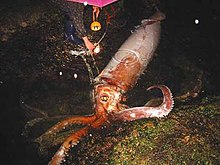In a groundbreaking achievement, scientists from The University of Western Australia and Kelpie Geosciences in the UK have captured on video a rare deep-sea hooked squid, one of the largest deep-water squids in the world. This remarkable footage was taken at a depth of over a kilometer underwater, shedding light on the mysterious and largely unexplored world of deep-sea creatures.
The deep-sea expedition, which spanned three months in the Pacific, resulted in the capture of unique footage of the elusive squid. The squid, known as Taningia danae, is renowned for having two large photophores on the end of two of its arms. These photophores produce bright bioluminescent flashes, used to startle and disorientate prey when hunting.
The footage was captured during the deployment of free-fall baited cameras north of an area known as the Samoan Passage. The squid was filmed at a depth of just over 1km, catching up with the lander as it was sinking to the seafloor at 58 meters per minute.

Associate Professor Heather Stewart, from Kelpie Geosciences UK and an adjunct at UWA, who served as the chief scientist on the expedition, expressed her excitement at the discovery. “As we were reviewing the footage, we realized we had captured something very rare,” she said.
The deep-sea hooked squid is one of the largest deep-water squids, but rather than the animal’s size, it was the lights that most interested scientists. The squid’s bioluminescent ‘headlights’ are a fascinating adaptation to the dark, high-pressure environment of the deep sea.
This discovery underscores the importance of deep-sea exploration and the use of advanced technology in uncovering the mysteries of our oceans. The footage provides invaluable insights into the behavior and adaptations of deep-sea creatures, contributing to our understanding of marine biodiversity.
The scientists’ achievement also highlights the potential for further discoveries in the largely uncharted territories of the deep sea. As technology advances and more deep-sea expeditions are undertaken, who knows what other incredible creatures we might find lurking in the depths?
In conclusion, the successful capture of the deep-sea hooked squid on video is a testament to the tireless efforts of the scientists from The University of Western Australia and Kelpie Geosciences in the UK. Their work continues to push the boundaries of our knowledge, bringing us one step closer to fully understanding the vast and mysterious world beneath the ocean’s surface.
This discovery is not just a triumph for the scientific community, but also a reminder of the wonders of nature that remain to be discovered, encouraging us to keep exploring, keep questioning, and keep pushing the boundaries of the known world.

